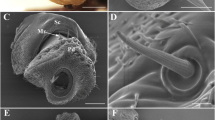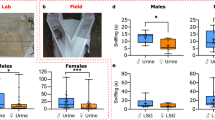Summary
-
1.
The internal nose of the vampire bat, Desmodus rotundus, is well developed. Besides the naso- and maxilloturbinal, four endoturbinals and three ectoturbinals are found.
-
2.
Two vampire bats were trained in a 5-choice-apparatus to find a small piece of filter paper, soaked with butyric acid. The minimum concentration the bats were able to detect was between 3.9 · 10−3 and 7.84 · 10−3 volume per cent butyric acid. A comparision with human subjects in a similar experimental situation showed that the vampires had a lower olfactory threshold. Human subjects were unable to smell butyric acid in the presented quantity below 3.12 · 10−2 volume per cent. These experiments prove that Desmodus is capable of olfactory orientation and may also use his sense of smell in nature to find his prey.
Zusammenfassung
-
l.
Die Ausbildung des Geruchsorgans der Vampirfledermäuse stellt diese zu den makrosmatischen Säugetieren. Es finden sich neben Naso- und Maxilloturbinale vier Endoturbinalia und drei Ectoturbinalia.
-
2.
In einer 5fach Wahlanlage wurden zwei Vampirfledermäuse darauf dressiert, mit Buttersäure getränkte Filterpapierplättchen aufzuspüren. Die Erkennungsschwelle lag zwischen 3,9 · 10−3 Vol.-% und 7.81 · 10−3 Vol.-% Buttersäure. Ein Vergleich mit Menschen in ähnlicher Versuchssituation zeigte, daß die Vampire ein besseres Geruchsvermögen besitzen. Die Menschen konnten die Buttersäure in der dargebotenen Quantität nur bis 3,12 · 10−2 Vol.-% wahrnehmen. Aus diesen Befunden läßt sich schließen, daß die Vampirfledermäuse auch in der Natur ihre Beutetiere geruchlich auffinden können.
Similar content being viewed by others
Literatur
Greenhall, A. M., Schmidt, U., L.-Forment, W.: Field observations on the mode of attack of the vampire bat, Desmodus rotundus, in Mexico. An. Inst. Biol. Univ. Mex. (in press).
Grosser, O.: Zur Anatomie der Nase und des Rachens der einheimischen Chiropteren. Morph. Jb. 29, 1–77 (1902).
Kolb, A.: Sinnesleistungen einheimischer Fledermäuse bei der Nahrungssuche und Nahrungsauswahl auf dem Boden und in der Luft. Z. vergl. Physiol. 44, 550–564 (1961).
Mann, G.: Neurobiologia de Desmodus rotundus. Invest. Zool. Chil. 6, 79–99 (1960).
—: Bulbus olfactorius accessorius in Chiroptera. J. comp. Neurol. 116, 135–141 (1961).
Möhres, F. P., Kulzer, E.: Über die Orientierung der Flughunde (ChiropteraPteropodidae). Z. vergl. Physiol. 38, 1–29 (1956).
Neuhaus, W.: Über die Riechschärfe des Hundes für Fettsäuren. Z. vergl. Physiol. 35, 527–552 (1953).
Rhine, S. B., Pratt, J. G.: Parapsychologie. Bern: Francke 1962.
Roer, H.: Zur Ernährungsbiologie von Plecotus auritus (L.) (Mam. Chiroptera). Bonner Zool. Beitr. 4, 378–383 (1969).
Suthers, R. A.: Vision, olfaction, taste. In: Wimsatt, Biology of bats, vol. II. New York-London: Academic Press 1970.
Author information
Authors and Affiliations
Additional information
Herrn Prof. Dr. H. Schneider danken wir für die freundliche Unterstützung der Arbeit.
Rights and permissions
About this article
Cite this article
Schmidt, U., Greenhall, A.M. Untersuchungen zur geruchlichen Orientierung der Vampirfledermäuse (Desmodus rotundus). Z. vergl. Physiologie 74, 217–226 (1971). https://doi.org/10.1007/BF00339933
Received:
Issue Date:
DOI: https://doi.org/10.1007/BF00339933




